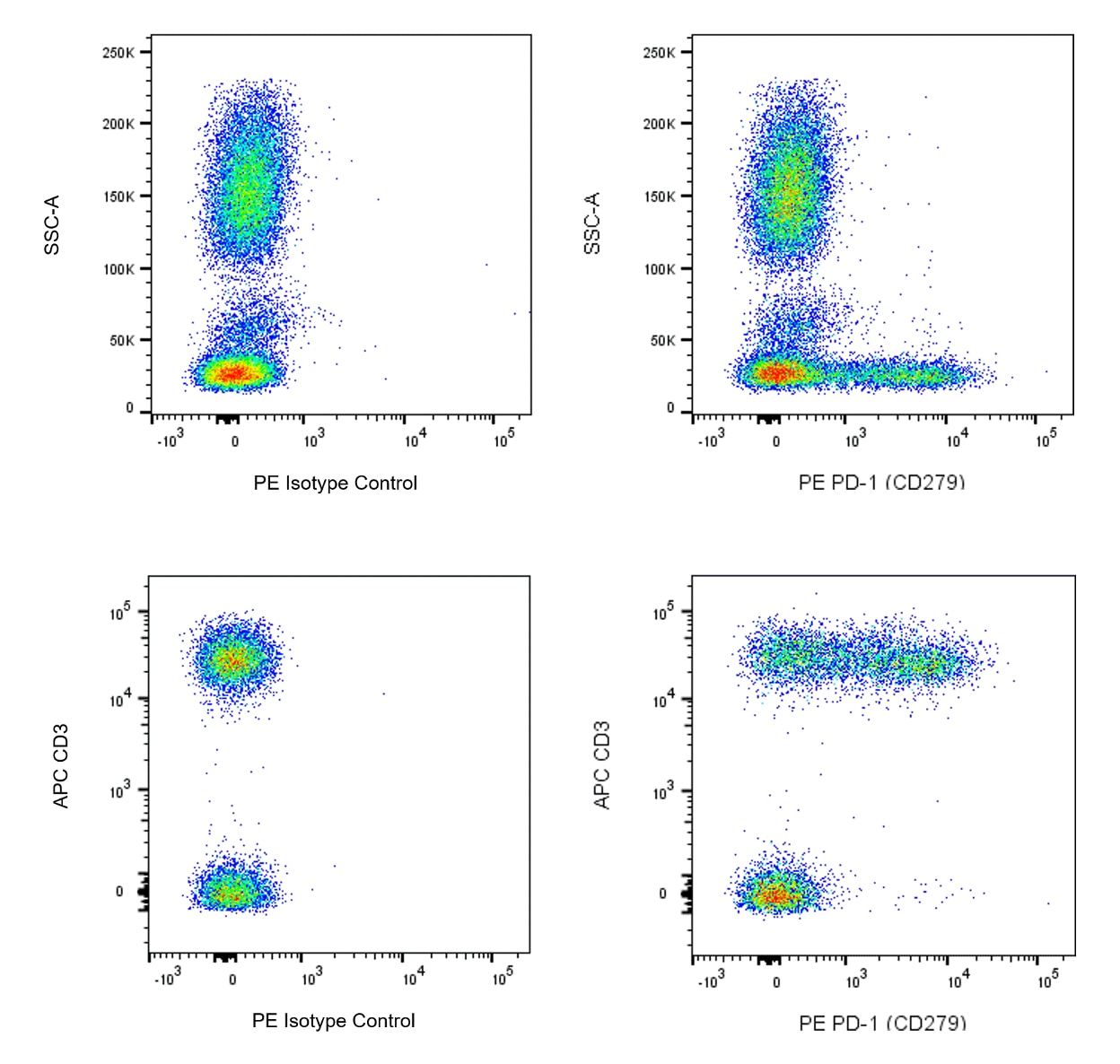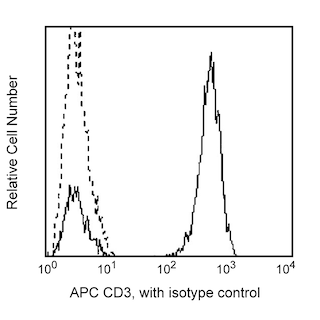Old Browser
This page has been recently translated and is available in French now.
Looks like you're visiting us from {countryName}.
Would you like to stay on the current country site or be switched to your country?


.png)

Flow cytometric analysis of PD-1 (CD279) expression on human peripheral blood leucocyte populations. Human whole blood was stained with APC Mouse Anti-Human CD3 antibody (Cat No. 561811/555335/561810) and either PE Mouse IgG1, κ Isotype Control (Cat No. 554680; Left Plots) or PE Mouse Anti-Human PD-1 (CD279) antibody (Cat No. 567618/567617; Right Plots). Erythrocytes were lysed with BD FACS™ Lysing Solution (Cat No. 349202). Flow cytometric analysis was performed using a BD LSRFortessa™ Flow Cytometer System and FlowJo™ software. Data shown on this Technical Data Sheet are not lot specific. Top Plots: Bivariate pseudocolor density plots showing correlated expression of PD-1 (CD279) [or Ig Isotype control staining] versus side light-scatter (SSC-A) signals were derived from gated events with the forward and side light-scatter characteristics of intact leucocytes. Bottom Plots: Bivariate pseudocolor density plots showing correlated expression of PD-1 (CD279) [or Ig Isotype control staining] versus CD3 were derived from gated events with the forward and side light-scatter characteristics of intact lymphocytes.
.png)

BD Pharmingen™ PE Mouse Anti-Human PD-1 (CD279)
.png)
Regulatory Status Legend
Any use of products other than the permitted use without the express written authorization of Becton, Dickinson and Company is strictly prohibited.
Preparation And Storage
Recommended Assay Procedures
BD® CompBeads can be used as surrogates to assess fluorescence spillover (Compensation). When fluorochrome conjugated antibodies are bound to BD® CompBeads, they have spectral properties very similar to cells. However, for some fluorochromes there can be small differences in spectral emissions compared to cells, resulting in spillover values that differ when compared to biological controls. It is strongly recommended that when using a reagent for the first time, users compare the spillover on cells and BD® CompBeads to ensure that BD® CompBeads are appropriate for your specific cellular application.
Product Notices
- This reagent has been pre-diluted for use at the recommended Volume per Test. We typically use 1 × 10^6 cells in a 100-µl experimental sample (a test).
- An isotype control should be used at the same concentration as the antibody of interest.
- Source of all serum proteins is from USDA inspected abattoirs located in the United States.
- Caution: Sodium azide yields highly toxic hydrazoic acid under acidic conditions. Dilute azide compounds in running water before discarding to avoid accumulation of potentially explosive deposits in plumbing.
- Please refer to www.bdbiosciences.com/us/s/resources for technical protocols.
- For fluorochrome spectra and suitable instrument settings, please refer to our Multicolor Flow Cytometry web page at www.bdbiosciences.com/colors.
- Please refer to http://regdocs.bd.com to access safety data sheets (SDS).
Companion Products






The NAT105 monoclonal antibody specifically recognizes CD279, which is also known as Programmed cell death 1 (PD-1). CD279 is an ~55 kDa type I transmembrane glycoprotein in the CD28/CTLA-4 family within the Ig superfamily and is encoded by the Pdcd1 gene. CD279 has an extracellular region with an IgV-like domain and an intracellular region with an immunoreceptor tyrosine-based inhibitory motif (ITIM) and an immunoreceptor tyrosine-based switch motif (ITSM). CD279 is a suppressive immunoregulatory receptor expressed on CD4-CD8- thymocytes, activated T cells, B cells and myeloid cells. CD273 (also known as PD-L2 or B7-H1) and CD274 (also known as PD-L1 or B7-DC), are ligands of CD279 and members of the B7 gene family. Upon binding, CD279 inhibits T cell proliferation and cytokine secretion. CD279 may play roles in supporting self-tolerance, reducing autoimmunity, or promoting T cell exhaustion associated with certain diseases. This antibody has been reported to be suitable for immunohistochemistry.

Development References (13)
-
Bekerman E, Hesselgesser J, Carr B, et al. PD-1 Blockade and TLR7 Activation Lack Therapeutic Benefit in Chronic Simian Immunodeficiency Virus-Infected Macaques on Antiretroviral Therapy.. Antimicrob Agents Chemother. 2019; 63(11):e01163-19. (Clone-specific: Flow cytometry). View Reference
-
Bennett F, Luxenberg D, Ling V, et al. Program death-1 engagement upon TCR activation has distinct effects on costimulation and cytokine-driven proliferation: attenuation of ICOS, IL-4, and IL-21, but not CD28, IL-7, and IL-15 responses. J Immunol. 2003; 170(2):711-718. (Biology). View Reference
-
Carter L, Fouser LA, Jussif J, et al. PD-1:PD-L inhibitory pathway affects both CD4(+) and CD8(+) T cells and is overcome by IL-2. Eur J Immunol. 2002; 32:634-643. (Biology). View Reference
-
Dorfman DM, Brown JA, Shahsafaei A, Freeman GJ. Programmed death-1 (PD-1) is a marker of germinal center-associated T cells and angioimmunoblastic T-cell lymphoma. Am J Surg Pathol. 2006; 30:802-810. (Biology). View Reference
-
Freeman GJ, Long AJ, Iwai Y, et al. Engagement of PD-1 immunoinhibitory receptor by a novel B7 family member leads to negative regulation of lymphocyte activation. J Exp Med. 2000; 192:1027-1034. (Biology). View Reference
-
Kanai T, Totsuka T, Uraushihara K, et al. Blockade of B7-H1 suppresses the development of chronic intestinal inflammation. J Immunol. 2003; 171(8):4156-4163. (Biology). View Reference
-
Kim KS, Sekar RR, Patil D, et al. Evaluation of programmed cell death protein 1 (PD-1) expression as a prognostic biomarker in patients with clear cell renal cell carcinoma.. Oncoimmunology. 7(4):e1413519. (Clone-specific: Immunohistochemistry). View Reference
-
Latchman Y, Wood CR, Chernova T, et al. PD-L2 is a second ligand for PD-1 and inhibits T cell activation. Nat Immunol. 2001; 2(3):261-268. (Biology). View Reference
-
Linedale R, Schmidt C, King BT, et al. Elevated frequencies of CD8 T cells expressing PD-1, CTLA-4 and Tim-3 within tumour from perineural squamous cell carcinoma patients.. PLoS One. 2017; 12(4):e0175755. (Clone-specific: Immunohistochemistry). View Reference
-
Nishimura H, Minato N, Nakano T, Honjo T. Immunological studies on PD-1 deficient mice: implication of PD-1 as a negative regulator for B cell responses. Int Immunol. 1998; 10(10):1563-1572. (Biology). View Reference
-
Pauken KE, Wherry EJ. Overcoming T cell exhaustion in infection and cancer. Trends Immunol. 2015; 36(4):265-273. (Biology). View Reference
-
Roncador G, García Verdes-Montenegro JF, Tedoldi S, et al. Expression of two markers of germinal center T cells (SAP and PD-1) in angioimmunoblastic T-cell lymphoma. Haematologica. 2007; 92(8):1059-66. (Clone-specific: Immunofluorescence, Immunohistochemistry, Western blot). View Reference
-
Velu V, Kannanganat S, Ibegbu C, et al. Elevated expression levels of inhibitory receptor programmed death 1 on simian immunodeficiency virus-specific CD8 T cells during chronic infection but not after vaccination. J Virol. 2007; 81(11):5819-5828. (Biology). View Reference
Please refer to Support Documents for Quality Certificates
Global - Refer to manufacturer's instructions for use and related User Manuals and Technical data sheets before using this products as described
Comparisons, where applicable, are made against older BD Technology, manual methods or are general performance claims. Comparisons are not made against non-BD technologies, unless otherwise noted.
For Research Use Only. Not for use in diagnostic or therapeutic procedures.
Report a Site Issue
This form is intended to help us improve our website experience. For other support, please visit our Contact Us page.